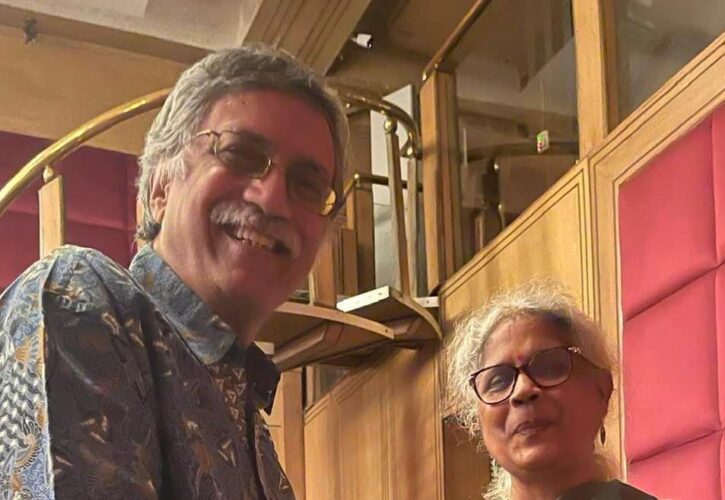GJV Prasad, formerly Professor of English at Jawaharlal Nehru University, is a writer, critic, and translator. His teaching and research have focused on Indian English literature, modern drama, and translation. 3). His publications on translation include Violets in a Crucible: Translating the Orient (co-edited with Madhu Benoit and Susan Blattes), India in Translation Translation in India (2019), Disability in Translation: The Indian Experience (co-edited with Someshwar Sati, 2019), and Reclaiming the Disabled Subject: Representing Disability in Short Fiction (Volume 1) (2022). He has translated two books so far from Tamil to English – Ambai’s collection of stories, A Red-necked Green Bird (2021), and Imayam’s novel Sellatha Panam, which in English is titled A Woman Burnt (2023).
Mangalam (BM): Your translation of Ambai’s Short Stories, A Red-necked Green Bird (2021) found a huge positive reception among readers and reviewers alike. Your translation of Imayam’s Sahitya Akademi award-winning novel Sellada Panam is your first attempt at translation of a novel. How was your experience in terms of engaging with a longer narrative and its form? Did you find it more challenging? Please share your specific strategies in translating short stories and a novel.
G. J. V. Prasad (GJV): The two genres have their own challenges as do the two writers! In terms of the genre, a collection of short stories allows you a certain freedom — you can translate any story first and you can take long breaks in between without worrying about losing the thread or missing the flow. When you translate a novel, you want to keep at it constantly so that you remember the translational choices you made and stick to them or revisit them. You have to worry about the pace of the novel and ensure that you work out the pace of the original and reproduce it. However, the novel allows you space and time for compensation, just as it does the writer. It is like building an innings in T 20 cricket as opposed to building an innings in test cricket. You can have a few tough overs in test cricket, play a difficult period out quietly, and then compensate for it later. T20 doesn’t allow you that luxury. Translating a short story is like T20 while translating a novel allows you to build effects, to make up for phases where you find it difficult to re-perform the way the other writer did. For example, you can repeat a word (either a loan word from the original or its translation) in different contexts to let it begin to play a role in the reader’s understanding, something the first mention would have accomplished in the original text.
BM: That’s an interesting metaphor and a revealing one! Imayam’s novel deploys conversation in a dramatic mode very successfully in Tamil. You have captured it well in the English language in A Woman Burnt. It is challenging to evoke the distinctive speech patterns of different characters in translation. Did it help that this novel is located not in a rural milieu, unlike some of the earlier novels of Imayam?
GJV: It is always challenging to translate dialogue, and to translate a language that is significantly rooted in a region. How does one translate the nuances of difference in language that indicate caste, community, gender, region, class, education, and profession? You have to ensure that there is no flattening out, that the readers perceive these differences even though they are reading it in a different language. Would I have found it more difficult to translate works set in a rural setting? I can’t say!
BM: I agree. And I am sure you shall find that opportunity soon. The novel depicts how love and marriage are embedded in class and caste divide in a patriarchal society like ours. But its sociological analysis is interwoven in an emotionally charged narrative. It raises a series of unnerving questions and makes us introspect our privileged, elitist position regarding status, merit and social validation. Did you find the process of translating this novel an emotionally draining experience?
GJV: This is a powerful novel, one that makes you pause time and again to think about the situation and how it could affect many of us. Imayam forces you to identify with each character, to empathise with each one. At the end of the novel, we feel Imayam has laid bare the bones of our lives, of our society, shown us who we are. It can be emotionally draining for the reader but it is a constructive process. Translating it was not so draining because I was so taken up by the act of writing a parallel text, figuring out how to rewrite it in a different language, to see if I managed to meet all the technical challenges!
BM: OK! Most of Imayam’s novels showcase a well-researched domain-experience, and in A woman Burnt, the verisimilitude of a Burns ward, a Police station, the procedural authenticity and the work culture of these places are captured evocatively. Share with us your experience as a reader and as a translator in this regard.
GJV: As a reader, you are aware of the truth value of what Imayam writes. You know he has observed things closely, done his research, and is depicting places and procedures as they are. As a translator you have to make your readers feel the same. When translating this novel, I sat with maps to familiarise myself with the places the novel is set in! This included the layout of JIPMER! I talked to doctor friends about hospital protocols with regard to burns wards. But I always had the book to guide me!
BM: That’s brilliant. And a useful heads-up for all translators! The original title in Tamil, Sellada Panam stands for counterfeit money or money that is invalidated. It captured well the realization of Revati’s family that their money cannot save their daughter’s life and reflected upon how economic disparity of families could ruin a couple’s marital life. The English title focuses on a woman’s immolation. Could you elaborate on the choice of the English title?
GJV: When I translated the novel, till the end, the working (and I thought the final) title was Worthless Money. I even toyed with the idea of having the title as simply Worthless. However, to my surprise, Imayam said when we were wrapping up that he would prefer I gave it a different title. It turned out that he hadn’t been happy with the reception/reading of the Thamizh title and therefore wished to change it. He felt that at best some readers reduced the meaning of the title to the worthlessness of money when it comes to the end of life. He wanted to turn the focus away from money directly while keeping all the implied themes of the book within sight. We finally came to this title since Revathi is a presence throughout the book especially because of her state, and because the title leaves you to think about the whys, to think of our society, our attitude to love (especially across various boundaries of region, class, and caste), our ideas of respectability and honour… The novel shows our society at work around this event.
BM: Imayam has observed that he was tired of clarifying that the reference to money in the original title had nothing to do with demonetisation! The English title scuttles such a reading but does it restrict the novel’s social analysis by focussing on the burnt woman’s body rather than on the social exclusion of the underprivileged in terms of their class location and cultural capital? The novel unravels the latter aspect much more rigorously.
GJV: As I said earlier, the title does not restrict its focus to the burnt woman’s body but makes us think about the possible altars she was burnt on. What was the cause? Each character in the novel, every reader, is complicit in the ways of our society, participates in various exclusions and the drawing of various boundaries. The novel itself is an offering at the altar of our conscience.
BM: Please share your approach to translation of a novel. Do you enjoy translating a poem or a short story more?
GJV: I enjoy the challenge of translating a poem. That said, this being the first novel I have translated, I must say I enjoyed it very much because of the challenge this particular novel posed, to keep the interest of the reader and reveal things while the reader already knows the central fact. Imayam manages it brilliantly in Thamizh, you want to read till the end even though you know how it will end in terms of the woman herself. To replicate what the novel does — show the ebb and flow of life in the environs of a hospital while making it an intense scrutiny of our society, to show how life goes on, to show how each one of us tries to assert our power in relationships and interactions with others, to show the grids we operate in and are restricted by – was the challenge. You have to get the conversations right. You have to get the pace right in various sections. You have to confront your own privileges and accept that you are complicit in all the power asymmetries in order to be able to translate effectively.
BM: You have managed to convey these very well indeed in the translated text. Congratulations, Prof. Prasad and thanks for making this novel accessible to the readers in English. And for completing the translation in a remarkably short span of time!
GJV: Thank you Mangalam. It makes me feel good to have the endorsement of such a wonderful critic and translator.
*









Brilliant!